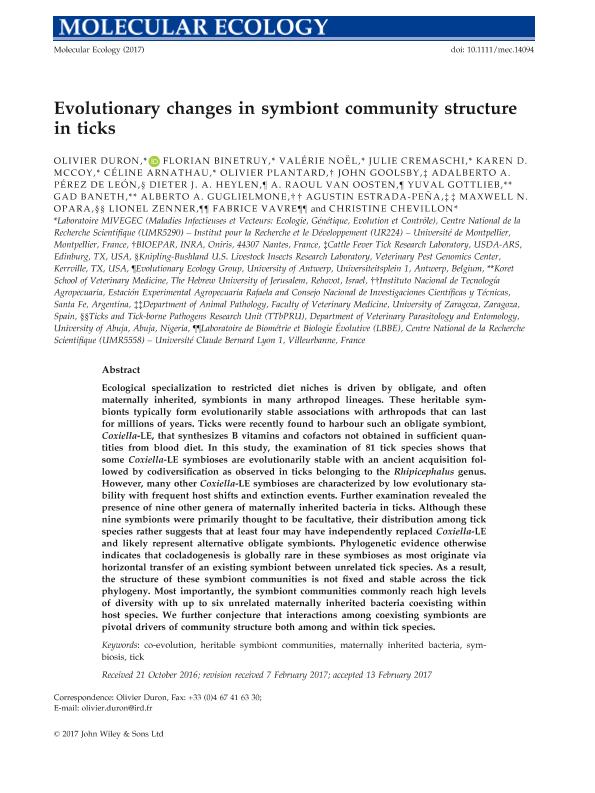Mostrar el registro sencillo del ítem
dc.contributor.author
Duron, Olivier
dc.contributor.author
Binetruy, Florian
dc.contributor.author
Noël, Valérie
dc.contributor.author
Cremaschi, Julie
dc.contributor.author
McCoy, Karen D.
dc.contributor.author
Arnathau, Céline
dc.contributor.author
Plantard, Olivier
dc.contributor.author
Goolsby, John
dc.contributor.author
Pérez de León, Adalberto A.
dc.contributor.author
Heylen, Dieter J. A.
dc.contributor.author
Van Oosten, A. Raoul
dc.contributor.author
Gottlieb, Yuval
dc.contributor.author
Baneth, Gad
dc.contributor.author
Guglielmone, Alberto Alejandro

dc.contributor.author
Estrada Peña, Agustin
dc.contributor.author
Opara, Maxwell N.
dc.contributor.author
Zenner, Lionel
dc.contributor.author
Vavre, Fabrice
dc.contributor.author
Chevillon, Christine
dc.date.available
2018-09-06T20:25:32Z
dc.date.issued
2017-06
dc.identifier.citation
Duron, Olivier; Binetruy, Florian; Noël, Valérie; Cremaschi, Julie; McCoy, Karen D.; et al.; Evolutionary changes in symbiont community structure in ticks; Wiley Blackwell Publishing, Inc; Molecular Ecology; 26; 11; 6-2017; 2905-2921
dc.identifier.issn
0962-1083
dc.identifier.uri
http://hdl.handle.net/11336/58622
dc.description.abstract
Ecological specialization to restricted diet niches is driven by obligate, and often maternally inherited, symbionts in many arthropod lineages. These heritable symbionts typically form evolutionarily stable associations with arthropods that can last for millions of years. Ticks were recently found to harbour such an obligate symbiont, Coxiella-LE, that synthesizes B vitamins and cofactors not obtained in sufficient quantities from blood diet. In this study, the examination of 81 tick species shows that some Coxiella-LE symbioses are evolutionarily stable with an ancient acquisition followed by codiversification as observed in ticks belonging to the Rhipicephalus genus. However, many other Coxiella-LE symbioses are characterized by low evolutionary stability with frequent host shifts and extinction events. Further examination revealed the presence of nine other genera of maternally inherited bacteria in ticks. Although these nine symbionts were primarily thought to be facultative, their distribution among tick species rather suggests that at least four may have independently replaced Coxiella-LE and likely represent alternative obligate symbionts. Phylogenetic evidence otherwise indicates that cocladogenesis is globally rare in these symbioses as most originate via horizontal transfer of an existing symbiont between unrelated tick species. As a result, the structure of these symbiont communities is not fixed and stable across the tick phylogeny. Most importantly, the symbiont communities commonly reach high levels of diversity with up to six unrelated maternally inherited bacteria coexisting within host species. We further conjecture that interactions among coexisting symbionts are pivotal drivers of community structure both among and within tick species.
dc.format
application/pdf
dc.language.iso
eng
dc.publisher
Wiley Blackwell Publishing, Inc

dc.rights
info:eu-repo/semantics/openAccess
dc.rights.uri
https://creativecommons.org/licenses/by-nc-sa/2.5/ar/
dc.subject
Co-Evolution
dc.subject
Heritable Symbiont Communities
dc.subject
Maternally Inherited Bacteria
dc.subject
Symbiosis
dc.subject
Tick
dc.subject.classification
Micología

dc.subject.classification
Ciencias Biológicas

dc.subject.classification
CIENCIAS NATURALES Y EXACTAS

dc.title
Evolutionary changes in symbiont community structure in ticks
dc.type
info:eu-repo/semantics/article
dc.type
info:ar-repo/semantics/artículo
dc.type
info:eu-repo/semantics/publishedVersion
dc.date.updated
2018-09-06T18:42:58Z
dc.journal.volume
26
dc.journal.number
11
dc.journal.pagination
2905-2921
dc.journal.pais
Reino Unido

dc.journal.ciudad
Londres
dc.description.fil
Fil: Duron, Olivier. Centre National de la Recherche Scientifique; Francia
dc.description.fil
Fil: Binetruy, Florian. Centre National de la Recherche Scientifique; Francia
dc.description.fil
Fil: Noël, Valérie. Centre National de la Recherche Scientifique; Francia
dc.description.fil
Fil: Cremaschi, Julie. Centre National de la Recherche Scientifique; Francia
dc.description.fil
Fil: McCoy, Karen D.. Centre National de la Recherche Scientifique; Francia
dc.description.fil
Fil: Arnathau, Céline. Centre National de la Recherche Scientifique; Francia
dc.description.fil
Fil: Plantard, Olivier. Institut National de la Recherche Agronomique; Francia
dc.description.fil
Fil: Goolsby, John. United States Department of Agriculture. Agriculture Research Service; Estados Unidos
dc.description.fil
Fil: Pérez de León, Adalberto A.. Veterinary Pest Genomics Center; Estados Unidos
dc.description.fil
Fil: Heylen, Dieter J. A.. Universiteit Antwerp; Bélgica
dc.description.fil
Fil: Van Oosten, A. Raoul. Universiteit Antwerp; Bélgica
dc.description.fil
Fil: Gottlieb, Yuval. The Hebrew University of Jerusalem; Israel
dc.description.fil
Fil: Baneth, Gad. The Hebrew University of Jerusalem; Israel
dc.description.fil
Fil: Guglielmone, Alberto Alejandro. Consejo Nacional de Investigaciones Científicas y Técnicas; Argentina. Instituto Nacional de Tecnología Agropecuaria. Centro Regional Buenos Aires; Argentina
dc.description.fil
Fil: Estrada Peña, Agustin. Universidad de Zaragoza; España
dc.description.fil
Fil: Opara, Maxwell N.. University Of Abuja; Nigeria
dc.description.fil
Fil: Zenner, Lionel. Centre National de la Recherche Scientifique; Francia
dc.description.fil
Fil: Vavre, Fabrice. Centre National de la Recherche Scientifique; Francia
dc.description.fil
Fil: Chevillon, Christine. Centre National de la Recherche Scientifique; Francia
dc.journal.title
Molecular Ecology

dc.relation.alternativeid
info:eu-repo/semantics/altIdentifier/doi/https://dx.doi.org/10.1111/mec.14094
dc.relation.alternativeid
info:eu-repo/semantics/altIdentifier/url/https://onlinelibrary.wiley.com/doi/abs/10.1111/mec.14094
Archivos asociados
